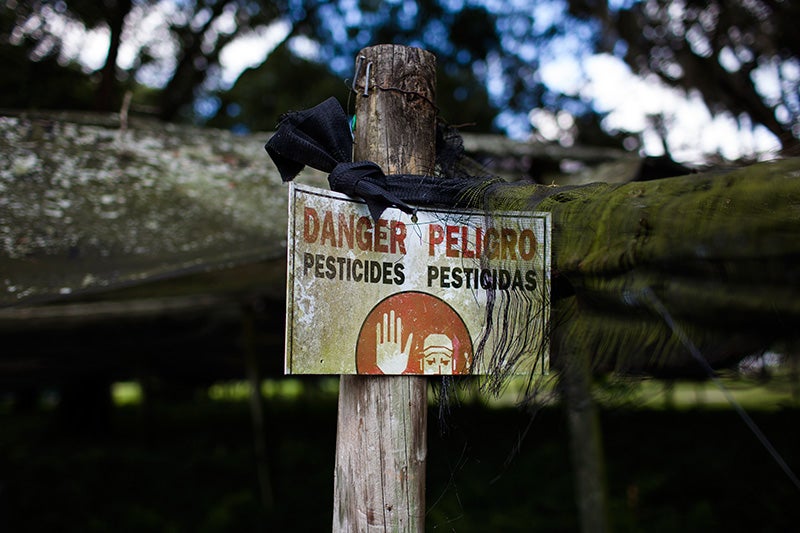EPA Asked to Investigate Pesticide Poisonings
Groups cite lack of confidence in Hawai‘i Department of Agriculture
Contact
Today national and Hawaiʻi-based groups formally called upon the U.S. Environmental Protection Agency’s Office of Enforcement and Compliance Assurance to investigate the recent pesticide poisoning that sent employees of Syngenta Seeds to the hospital.
Syngenta and other companies use chlorpyrifos heavily on the genetically engineered seed crops they grow on thousands of acres on Kauaʻi.
On January 20, 2016, workers walked into a Syngenta field in Kekaha, on Kauaʻi’s west side, after it had been sprayed with chlorpyrifos, and were taken to the hospital for treatment. Syngenta has refused to provide information about the incident, such as how many workers were affected or the treatment they received, whether Syngenta had directed them to enter the field, and whether warning signs had been posted.
Earthjustice, Farmworker Justice, Pesticide Action Network, Hawaiʻi Alliance for Progressive Action, Hawai‘i SEED, Farmworker Association of Florida, and The MOM Hui are asking EPA to step in and ensure that a thorough investigation is performed and the results made public.
Earthjustice attorney Paul Achitoff commented, “Time and again, Hawaiʻi authorities have turned their back on Hawaiʻi’s residents and farmworkers in favor of agrochemical companies. We have no confidence that an investigation by the Hawaiʻi Department of Agriculture will get to the bottom of this incident, or take measures to ensure these poisonings stop. We expect the EPA to get involved immediately and ensure the facts are found and made public, and appropriate enforcement action is taken.”
Chlorpyrifos is a potent neurotoxin. Extensive scientific evidence ties the pesticide to nervous system damage and persistent developmental disorders, as well as autoimmune conditions, lung cancer, colorectal cancer and non-Hodgkin’s lymphoma. Exposure during pregnancy can stunt a child’s mental development and permanently lower IQ.
Syngenta and other companies use the chemical heavily on the genetically engineered seed crops they grow on thousands of acres on Kauaʻi, as well as on Oʻahu, Maui, and Molokaʻi, mostly near low-income communities. EPA banned most home use of almost all chlorpyrifos products in 2001, and recently proposed to revoke all food residue tolerances for the pesticide. After the January 20, 2016 incident, Syngenta said it has no plans to discontinue using the chemical.
“This unfortunate incident underscores the urgent need for stronger protections for farmworkers, who are at greatest risk of harm from daily direct exposure to pesticides,” said Virginia Ruiz, Director of Occupational and Environmental Health at Farmworker Justice. “The EPA must conduct a thorough investigation to determine why these workers did not receive adequate notification or protective equipment to prevent their exposure to a neurotoxic pesticide, and whether the subsequent medical treatment was sufficient to address the harm to their health.”
This is not the first time chlorpyrifos has caused harm in Hawaiʻi. After dozens of teachers and children at Waimea Canyon Middle School, also near Syngenta’s Kauaʻi fields, were taken to the hospital with symptoms consistent with pesticide poisoning on several occasions between November 2006 and April 2008, the Hawaiʻi Department of Agriculture funded an investigation more than a year later. It found chlorpyrifos and other pesticides in air samples at the school, but attributed all of the symptoms to the presence of “stinkweed,” a common plant.
The Hawaiʻi Department of Health found chlorpyrifos in the canals that drain the companies’ West Kauaʻi fields and empty into the nearshore waters where residents fish and surf, after passing directly through Kekaha.
Nor would this be the first time Syngenta has violated EPA’s Worker Protection Standard, designed to prevent this type of harm. In 2008, Syngenta was fined for failing to post the spraying of the pesticide Liberty (sulfentrazone and imazethapyr), among other violations. Syngenta and other agrochemical companies have opposed efforts to protect residents from pesticide drift in Hawaiʻi, including by suing Kauaʻi County to overturn an ordinance the Kauaʻi County Council passed in 2013 to require disclosure and buffer zones around schools, hospitals, and waterways, and by lobbying against bills introduced in the Hawaiʻi State Legislature seeking similar measures.
Achitoff added, “EPA’s website tells us its Office of Enforcement and Compliance Assurance ‘goes after pollution problems that impact American communities through vigorous civil and criminal enforcement that targets the most serious water, air and chemical hazards. As part of this mission, we work to advance environmental justice by protecting communities most vulnerable to pollution.’ That’s exactly what we need now.”

Additional Resources
About Earthjustice
Earthjustice is the premier nonprofit environmental law organization. We wield the power of law and the strength of partnership to protect people's health, to preserve magnificent places and wildlife, to advance clean energy, and to combat climate change. We are here because the earth needs a good lawyer.